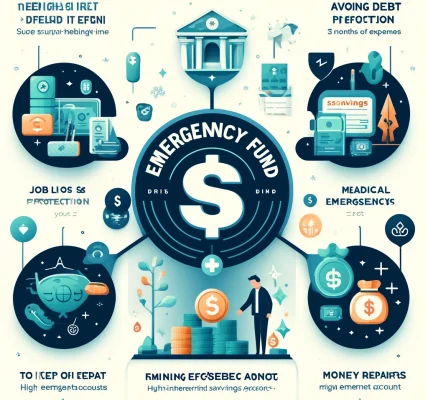Saving money is often seen as a luxury reserved for those with high salaries or abundant wealth. However, no matter how small your income is, it’s possible to start saving and gradually build wealth over time. The key is discipline, planning, and setting realistic goals. In this blog post, we will guide you through practical and effective ways to start saving money, even with a small income.
Why Saving is Important, Even on a Small Income?
Saving money provides you with a safety net for emergencies, a cushion for unexpected expenses, and a stepping stone toward long-term financial goals like buying a home, retirement, or even just living comfortably. Starting small doesn’t mean you won’t be able to achieve big results down the road. Every little bit counts, and even modest savings can accumulate into something substantial over time.
1. Track Your Expenses
Step 1: Before you start saving, it’s crucial to understand where your money is going. Tracking your expenses will give you a clear picture of your spending habits. This way, you can identify areas where you can cut back or adjust.
- Use budgeting apps like Mint, YNAB (You Need a Budget), or PocketGuard to categorize your expenses.
- Try the 50/30/20 rule, where 50% of your income goes toward essentials (like rent, utilities), 30% goes to non-essentials (entertainment, dining), and 20% should be allocated to savings.
Tracking your expenses will give you insight into how much you can realistically save each month.
SEO Tip: Keywords like “expense tracking,” “budgeting apps,” and “50/30/20 rule” can be optimized.
2. Set a Realistic Saving Goal
Step 2: Once you have a clear idea of your monthly expenses, it’s time to set a realistic saving goal. Depending on your income and expenses, a goal could be as modest as saving $100 a month or building an emergency fund of $500 over a few months.
Your savings goal doesn’t need to be grandiose—what matters is that it’s achievable. You can adjust the goal as your income or circumstances change. For example:
- Build a small emergency fund to cover unexpected expenses (around $500-$1,000).
- Set aside a specific amount for short-term goals (like a vacation, a new gadget, or a special event).
- Focus on long-term goals like retirement savings or a down payment on a house.
SEO Tip: Use keywords like “setting realistic saving goals,” “emergency fund,” and “saving for short-term goals.”
3. Automate Your Savings
Step 3: The easiest way to save consistently is to automate your savings. Once you’ve tracked your expenses and set a goal, you can set up automatic transfers from your checking account to a savings account. This ensures that you save before you spend, which is key to building financial discipline.
- Use apps like Acorns or Digit to round up your purchases and save the change.
- Set up a direct deposit from your paycheck to your savings account.
- Use online banks or high-yield savings accounts that offer automatic transfers and easy withdrawal options.
By automating your savings, you remove the temptation to spend the money and stay consistent with your goals.
SEO Tip: Keywords like “automated savings,” “automatic transfers,” and “save before spending” work well here.
4. Cut Unnecessary Expenses
Step 4: Once you’ve tracked your spending and set a saving goal, it’s time to evaluate your spending habits and see where you can cut back. Cutting unnecessary expenses doesn’t mean you need to live a deprived life—it’s about being mindful of your spending.
Here are some ways to save:
- Cook at home instead of dining out.
- Cancel unused subscriptions or memberships (like streaming services, gym memberships, etc.).
- Buy in bulk for items you use frequently, such as toiletries, non-perishable foods, or cleaning supplies.
- Take advantage of sales, discounts, and couponing for daily essentials.
These small adjustments can free up more money for your savings fund.
SEO Tip: Target keywords like “cutting unnecessary expenses,” “saving money on food,” and “cancel unused subscriptions.”
5. Start With a High-Interest Savings Account
Step 5: When you begin saving, choose an account that offers a high interest rate. While interest rates for savings accounts are generally low, online savings accounts often offer higher returns than traditional brick-and-mortar banks. This can make a significant difference over time.
Look for accounts that offer:
- No monthly fees.
- Higher interest rates (compared to regular savings accounts).
- Easy access to your funds, if needed.
By choosing a high-yield savings account, you can maximize the returns on the money you set aside, even if it’s a small amount.
SEO Tip: Keywords like “high-yield savings account,” “best savings interest rates,” and “online savings account” can be used.
6. Invest Small Amounts for Long-Term Growth
Step 6: Once you’ve started saving consistently, consider investing small amounts for long-term growth. Many people think investing requires a large amount of capital, but there are plenty of ways to invest even with a small income.
- Robo-advisors like Betterment or Wealthfront allow you to invest with as little as $100.
- You can also consider mutual funds or index funds, which offer diversification at a relatively low cost.
- If you’re open to risk, start investing in stocks or ETFs through platforms like Robinhood or E*TRADE.
Investing is a great way to grow your savings over time, especially if you start early and commit to small, regular contributions.
SEO Tip: Use keywords like “small amount investing,” “robo-advisors,” “index funds for beginners,” and “investing with small income.”
7. Build a Side Income
Step 7: If your current income barely covers your expenses, it might be worth considering ways to boost your income through a side hustle. Whether it’s freelancing, tutoring, or selling handmade crafts, any extra income you can generate can be allocated toward your savings.
Side hustles can be a great way to reach your savings goals faster, especially if you’re struggling to make ends meet on a small income.
SEO Tip: Keywords like “side hustle ideas,” “earning extra income,” and “freelancing for beginners” can be helpful here.
Conclusion: Start Small, Think Big
Saving money with a small income might seem challenging, but it is entirely possible with discipline, patience, and smart planning. By tracking your expenses, setting realistic goals, automating your savings, and making small adjustments to your spending habits, you can begin building a solid financial foundation.



